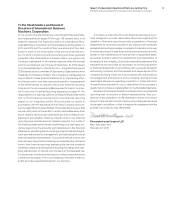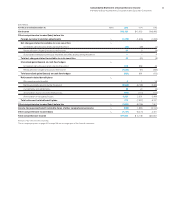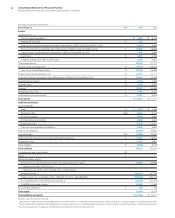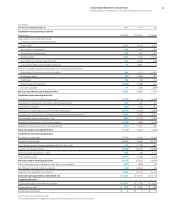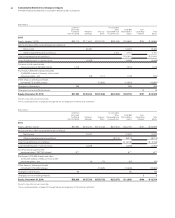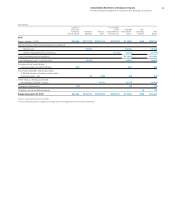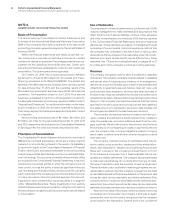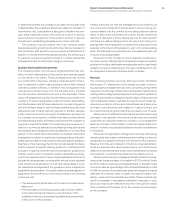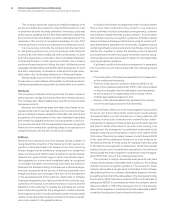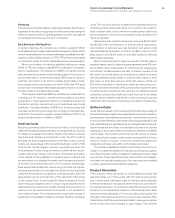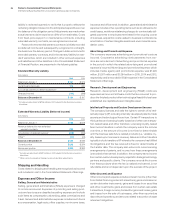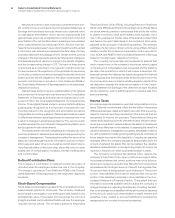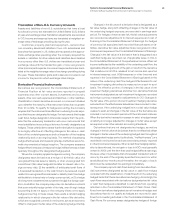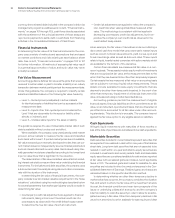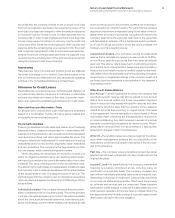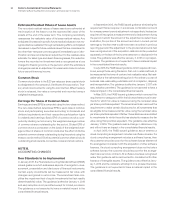IBM 2015 Annual Report Download - page 87
Download and view the complete annual report
Please find page 87 of the 2015 IBM annual report below. You can navigate through the pages in the report by either clicking on the pages listed below, or by using the keyword search tool below to find specific information within the annual report.Notes to Consolidated Financial Statements
International Business Machines Corporation and Subsidiary Companies
85
Financing
Financing income attributable to sales-type leases, direct financ-
ing leases and loans is recognized on the accrual basis using the
effective interest method. Operating lease income is recognized
on a straight-line basis over the term of the lease.
Best Estimate of Selling Price
In certain instances, the company is not able to establish VSOE
for all elements in a multiple-deliverable arrangement. When VSOE
cannot be established, the company attempts to establish the sell-
ing price of each element based on TPE. TPE is determined based
on competitor prices for similar deliverables when sold separately.
When the company is unable to establish selling price using
VSOE or TPE, the company uses BESP in its allocation of arrange-
ment consideration. The objective of BESP is to determine the
price at which the company would transact a sale if the product or
service were sold on a stand-alone basis. BESP may be used, for
example, if a product is not sold on a stand-alone basis or when
the company sells a new product, for which VSOE and TPE does
not yet exist, in a multiple-deliverable arrangement prior to selling
the new product on a stand-alone basis.
The company determines BESP by considering multiple factors
including, but not limited to, overall market conditions, including
geographic or regional specific factors, competitive positioning,
competitor actions, internal costs, profit objectives and pricing
practices. The determination of BESP is a formal process that
includes review and approval by the company’s management.
In addition, the company regularly reviews VSOE and TPE for its
products and services, in addition to BESP.
Services Costs
Recurring operating costs for services contracts, including costs
related to bid and proposal activities, are recognized as incurred.
For fixed-price design and build contracts, the costs of external
hardware and software accounted for under the POC method
are deferred and recognized based on the labor costs incurred
to date, as a percentage of the total estimated labor costs to fulfill
the contract. Certain eligible, nonrecurring costs incurred in the
initial phases of outsourcing contracts are deferred and subse-
quently amortized. These costs consist of transition and setup
costs related to the installation of systems and processes and
are amortized on a straight-line basis over the expected period
of benefit, not to exceed the term of the contract. Additionally,
fixed assets associated with outsourcing contracts are capital-
ized and depreciated on a straight-line basis over the expected
useful life of the asset. If an asset is contract specific, then the
depreciation period is the shorter of the useful life of the asset
or the contract term. Amounts paid to clients in excess of the fair
value of acquired assets used in outsourcing arrangements are
deferred and amortized on a straight-line basis as a reduction of
revenue over the expected period of benefit not to exceed the
term of the contract. The company performs periodic reviews to
assess the recoverability of deferred contract transition and setup
costs. This review is done by comparing the estimated minimum
remaining undiscounted cash flows of a contract to the unamor-
tized contract costs. If such minimum undiscounted cash flows
are not sufficient to recover the unamortized costs, an impairment
loss is recognized.
Deferred services transition and setup costs were $2,144 million
and $2,230 million at December31, 2015 and 2014, respectively.
Amortization of deferred services transition and setup costs
was estimated at December31, 2015 to be $653million in 2016,
$522million in 2017, $366million in 2018, $254million in 2019 and
$349million thereafter.
Deferred amounts paid to clients in excess of the fair value of
acquired assets used in outsourcing arrangements were $184mil-
lion and $64million at December31, 2015 and 2014, respectively.
Amortization of deferred amounts paid to clients in excess of the
fair value of acquired assets is recorded as an offset of revenue
and was estimated at December31, 2015 to be $53million in 2016,
$41million in 2017, $39million in 2018, $21million in 2019 and
$30million thereafter. In situations in which an outsourcing con-
tract is terminated, the terms of the contract may require the client
to reimburse the company for the recovery of unbilled accounts
receivable, unamortized deferred costs incurred to purchase
specific assets utilized in the delivery of services and to pay any
additional costs incurred by the company to transition the services.
Software Costs
Costs that are related to the conceptual formulation and design of
licensed software programs are expensed as incurred to research,
development and engineering expense; costs that are incurred
to produce the finished product after technological feasibility has
been established are capitalized as an intangible asset. Capital-
ized amounts are amortized on a straight-line basis over periods
ranging up to three years and are recorded in software cost within
cost of sales. The company performs periodic reviews to ensure
that unamortized program costs remain recoverable from future
revenue. Costs to support or service licensed programs are
charged to software cost within cost of sales as incurred.
The company capitalizes certain costs that are incurred to pur-
chase or to create and implement internal-use software programs,
including software coding, installation, testing and certain data
conversions. These capitalized costs are amortized on a straight-
line basis over periods ranging up to two years and are recorded
in selling, general and administrative expense.
Product Warranties
The company offers warranties for its hardware products that
generally range up to three years, with the majority being either
one or three years. Estimated costs for warranty terms standard
to the deliverable are recognized when revenue is recorded for
the related deliverable. The company estimates its warranty costs
standard to the deliverable based on historical warranty claim
experience and estimates of future spending, and applies this
estimate to the revenue stream for products under warranty. Esti-
mated future costs for warranties applicable to revenue recognized
in the current period are charged to cost of sales. The warranty


